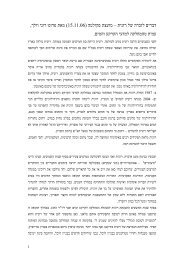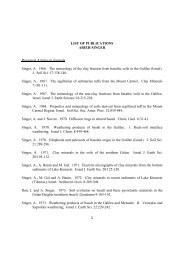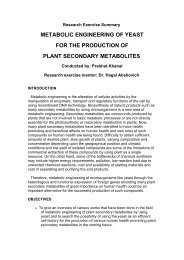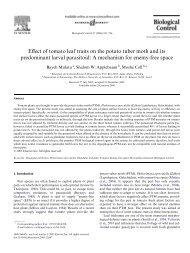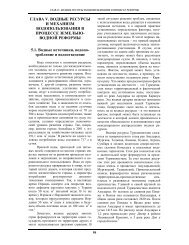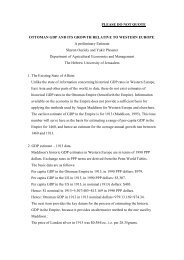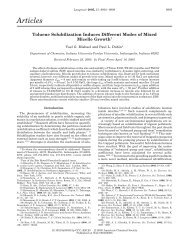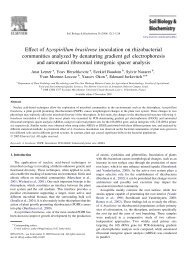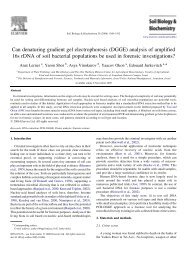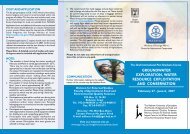Neurokinin Bs and neurokinin B receptors in zebrafish- potential role ...
Neurokinin Bs and neurokinin B receptors in zebrafish- potential role ...
Neurokinin Bs and neurokinin B receptors in zebrafish- potential role ...
You also want an ePaper? Increase the reach of your titles
YUMPU automatically turns print PDFs into web optimized ePapers that Google loves.
Support<strong>in</strong>g Information<br />
Biran et al. 10.1073/pnas.1119165109<br />
SI Materials <strong>and</strong> Methods<br />
Data M<strong>in</strong><strong>in</strong>g, Phylogenetic Analysis, <strong>and</strong> Chromosomal Synteny. The<br />
putative Tac3 gene sequences were isolated from <strong>zebrafish</strong> us<strong>in</strong>g<br />
a stepwise evolutionary strategy. First, a prote<strong>in</strong> blast was run<br />
us<strong>in</strong>g the mouse Tac2 prote<strong>in</strong> (NP_033338.2) as <strong>in</strong>put. The lowest<br />
scor<strong>in</strong>g sequence that still had the <strong>neurok<strong>in</strong><strong>in</strong></strong> signature of<br />
FxGLM (XP_001365310, Monodelphis domesitca) was used as<br />
<strong>in</strong>put for a genomic search aga<strong>in</strong>st the platypus genome. One<br />
region was found (ornAna1, Contig39139:6403–6445), which<br />
translated to GDMHDFFVGLMGKR. This sequence was used<br />
as <strong>in</strong>put to translated blast of fish DNA <strong>and</strong> EST sequences.<br />
Several ESTs were found that were built <strong>in</strong>to two consensus<br />
contigs (tac3a <strong>and</strong> tac3b), align<strong>in</strong>g to two dist<strong>in</strong>ct regions <strong>in</strong> the<br />
<strong>zebrafish</strong> genome (chr 23 <strong>and</strong> 6, respectively). The cDNAs were<br />
cloned based on the EST contigs, <strong>and</strong> the sequences have been<br />
submitted to GenBank (tac3a: JN392856; tac3b: JN392857).<br />
Because of the fact that these genes had more than one putative<br />
active peptide, <strong>and</strong> the difference <strong>in</strong> sequence between the<br />
mammalian <strong>and</strong> fish sequences, it was decided to isolate as many<br />
fish <strong>and</strong> mammalian sequences as possible to be sure of the<br />
identification of orthology as opposed to paralogy. An additional<br />
27 fish tac genes were found, us<strong>in</strong>g the <strong>zebrafish</strong> prote<strong>in</strong> as an<br />
<strong>in</strong>put to tblastn aga<strong>in</strong>st the nucleotide <strong>and</strong> EST databases at the<br />
National Center for Biotechnology Information; 23 of the fish<br />
<strong>and</strong> 4 of the nonfish (alligator, frog, chicken, <strong>and</strong> pig) tacs were<br />
built from ESTs, <strong>and</strong> these have been submitted to GenBank<br />
with the follow<strong>in</strong>g accession numbers BK008100–BK008126.<br />
The human TAC genes have several isoforms, the ones that<br />
didn’t cause species-specific gaps or extensions <strong>in</strong> prelim<strong>in</strong>ary<br />
alignments were chosen for the f<strong>in</strong>al alignments <strong>and</strong> trees. The<br />
tac3ra <strong>and</strong> tac3rb sequences were cloned based on the predicted<br />
gene sequences <strong>in</strong> GenBank. The tac3rc was found <strong>in</strong> a genomic<br />
search, <strong>and</strong> once aga<strong>in</strong>, more sequences were then sought to<br />
ensure proper classification of the <strong>receptors</strong>. Additional 19 fish<br />
tac3 <strong>receptors</strong> were found, many with genomic predictions. The<br />
genomic predictions were manually created, <strong>and</strong> 13 were improved<br />
<strong>and</strong> deposited <strong>in</strong> GenBank (accession nos.: BK008087–<br />
BK008099). Phylogenetic analysis was performed us<strong>in</strong>g both<br />
neighbor-jo<strong>in</strong><strong>in</strong>g (ClustalW 2.1) <strong>and</strong> maximum likelihood (Phylip<br />
3.69, ProML (1) on the basis of alignments performed both by<br />
ClustalW (2) <strong>and</strong> Muscle (3.8.31) (3). The topologies were the<br />
same <strong>in</strong> all comb<strong>in</strong>ations of multiple alignment <strong>and</strong> tree construction<br />
programs. Bootstrapp<strong>in</strong>g of 1,000 was performed on<br />
the neighbor-jo<strong>in</strong><strong>in</strong>g <strong>and</strong> of 100 on the maximum-likelihood<br />
trees. Trees were visualized with FigTree 1.3.1 (4). Synteny was<br />
observed us<strong>in</strong>g the University of California at Santa Cruz genome<br />
browser <strong>and</strong> the follow<strong>in</strong>g genome builds: human: hg19<br />
(5); <strong>zebrafish</strong>: Zv9/danRer7; medaka: oryLat2; Tetraodon: tet-<br />
Nig2; Fugu: fr2.<br />
In Situ Hybridization Analysis of Embryos <strong>and</strong> Adults. Adult wild-type<br />
<strong>zebrafish</strong> were ma<strong>in</strong>ta<strong>in</strong>ed at 27–28 °C on a 14 h:10 h (light:dark)<br />
1. Felsenste<strong>in</strong> J (2005) PHYLIP (Phylogeny Inference Package) version 3.6. (Distributed by<br />
the author, Department of Genome Sciences) (University of Wash<strong>in</strong>gton, Seattle, WA).<br />
2. Lark<strong>in</strong> MA, et al. (2007) Clustal W <strong>and</strong> Clustal X version 2.0. Bio<strong>in</strong>formatics 23:<br />
2947–2948.<br />
3. Edgar RC (2004) MUSCLE: Multiple sequence alignment with high accuracy <strong>and</strong> high<br />
throughput. Nucleic Acids Res 32:1792–1797.<br />
4. Rambaut A (2007) FigTree, a graphical viewer of phylogenetic trees. Available at:<br />
http://tree.bio.ed.ac.uk/software/figtree/. Accessed July, 2011.<br />
cycle, <strong>and</strong> fed a range of dry fish food <strong>and</strong> artemia twice daily.<br />
Embryos were generated from natural crosses by breed<strong>in</strong>g the<br />
male/female pairs.<br />
A fragment of <strong>zebrafish</strong> tac3a (Table S1) was cloned <strong>in</strong>to<br />
pGEM-T easy vector. Antisense <strong>and</strong> sense riboprobes were synthesized<br />
(Dig RNA label<strong>in</strong>g kit; Roche Diagnostics) us<strong>in</strong>g SpeI or<br />
NcoI l<strong>in</strong>earized (respectively) plasmids as templates <strong>and</strong> wholemount<br />
<strong>in</strong> situ hybridization was conducted accord<strong>in</strong>g to ref. 6.<br />
We used 0.6–0.8 g sexually mature <strong>zebrafish</strong>. Fish were first<br />
anesthetized with MS-222 (Sigma) <strong>and</strong> decapitated. Bra<strong>in</strong>s were<br />
removed <strong>and</strong> fixed with 4% (wt/vol) paraformaldehyde <strong>in</strong> PBS<br />
for 6 h at 4 °C <strong>and</strong> immersed <strong>in</strong> PBS conta<strong>in</strong><strong>in</strong>g 20% (wt/vol)<br />
sucrose <strong>and</strong> 30% (vol/vol) optimal cutt<strong>in</strong>g temperature (OCT)<br />
(Sakura) for about 24 h. Bra<strong>in</strong>s were then embedded <strong>in</strong> OCT,<br />
frozen <strong>in</strong> liquid nitrogen, sectioned frontally at 12 μm on<br />
a cryostat at −18 °C, <strong>and</strong> mounted onto Superfrost plus glass<br />
slides (Thermo Scientific).<br />
To detect tac3a <strong>and</strong> tac3b mRNA, we prepared a specific digoxigen<strong>in</strong><br />
(DIG)-labeled riboprobe for tac3a (position 122–360<br />
<strong>in</strong> GenBank accession no. JN392856), tac3b (position 17–246 <strong>in</strong><br />
GenBank accession no. JN392857). Probes were prepared us<strong>in</strong>g<br />
DIG RNA label<strong>in</strong>g kit (SP6/T7; Roche).<br />
In situ hybridization was generally performed as described <strong>in</strong> ref.<br />
7, with slight modifications. Briefly, sections were washed twice <strong>in</strong><br />
PBS, treated with 1 μg/mL protease K for 15 m<strong>in</strong> at 37 °C,<br />
postfixed with 4% paraformaldehyde <strong>in</strong> PBS for 15 m<strong>in</strong>, <strong>and</strong> <strong>in</strong>cubated<br />
with 0.25% acetic anhydride <strong>in</strong> 0.1 M triethanolam<strong>in</strong>e for<br />
10 m<strong>in</strong>. Then the sections were prehybridized at 58 °C for 1 h <strong>in</strong><br />
hybridization buffer conta<strong>in</strong><strong>in</strong>g 50% (vol/vol) formamide, 5× sal<strong>in</strong>e<br />
sodium citrate (SSC), 0.12 M phosphate buffer (pH 7.4), 100<br />
μg/mL tRNA. Slides were <strong>in</strong>cubated at 58 °C overnight <strong>in</strong> the<br />
same solution conta<strong>in</strong><strong>in</strong>g 1 μg/mL denatured riboprobe. We used<br />
diethyl pyrocarbonate-treated water for the preparation of all<br />
solutions for treatment before hybridization.<br />
After hybridization, sections were washed twice with 50%<br />
formamide <strong>and</strong> 2× SSC followed by two washes of 2× SSC <strong>and</strong><br />
two washes of 0.5× SSC for 15 m<strong>in</strong> each at 58 °C. Slides were<br />
immersed <strong>in</strong> DIG-1 (0.1 M Tris-HCl, 0.16 M NaCl, <strong>and</strong> 0.1%<br />
Tween 20) for 5 m<strong>in</strong>, 1.5% (vol/vol) block<strong>in</strong>g reagent with DIG-1<br />
for 30 m<strong>in</strong>, <strong>and</strong> DIG-1 for 15 m<strong>in</strong>, <strong>and</strong> then <strong>in</strong>cubated with an<br />
alkal<strong>in</strong>e phosphatase-conjugated anti-DIG antibody (diluted<br />
1:1,000 with DIG-1; Roche) for at least 2 h. Sections were<br />
washed with DIG-1 twice for 15 m<strong>in</strong> each, <strong>and</strong> DIG-3 (0.1 M<br />
Tris-HCl, pH 9.5; 0.1 M NaCl; 0.05 M MgCl2) for 5 m<strong>in</strong>. Sections<br />
were then treated with a chromogenic substrate NBT/BCIP<br />
stock solution (Roche) diluted 1:250 (vol/vol) <strong>in</strong> DIG-3 until<br />
a visible signal was detected. Sections were immersed <strong>in</strong> a reaction<br />
stop solution (10 mM Tris-HCl, pH8.0; 1 mM EDTA,<br />
pH8.0) to stop the chromogenic reaction. Sections were then<br />
dehydrated, covered us<strong>in</strong>g ClearMount Mount<strong>in</strong>g Solution (Invitrogen)<br />
<strong>and</strong> exam<strong>in</strong>ed us<strong>in</strong>g light microscopy.<br />
5. Kent WJ, et al. (2002) The human genome browser at UCSC. Genome Res 12:996–1006.<br />
6. Palevitch O, et al. (2007) Ontogeny of the GnRH systems <strong>in</strong> <strong>zebrafish</strong> bra<strong>in</strong>: In situ<br />
hybridization <strong>and</strong> promoter-reporter expression analyses <strong>in</strong> <strong>in</strong>tact animals. Cell Tissue<br />
Res 327:313–322.<br />
7. Mitani Y, K<strong>and</strong>a S, Akazome Y, Zempo B, Oka Y (2010) Hypothalamic Kiss1 but not<br />
Kiss2 neurons are <strong>in</strong>volved <strong>in</strong> estrogen feedback <strong>in</strong> medaka (Oryzias latipes).<br />
Endocr<strong>in</strong>ology 151:1751–1759.<br />
Biran et al. www.pnas.org/cgi/content/short/1119165109 1of9



